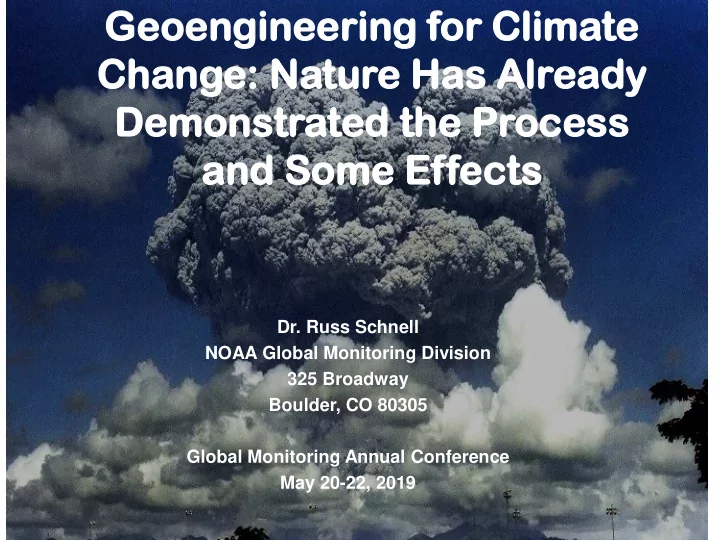

Geoengi gine neeri ring f ng for C r Climate te Cha hang nge: Na Natu ture Ha Has A Already Demon onstrated the d the Pr Proc ocess and Som nd Some Ef Effects Dr. Russ Schnell NOAA Global Monitoring Division 325 Broadway Boulder, CO 80305 Global Monitoring Annual Conference May 20-22, 2019
Increasing Atmospheric CO 2 and CH 4 is Unplanned Geoengineering Global CO 2 Trends CH 4 CO 2
Natural and overt geoengineering Volcanic eruptions provide test cases for the effects of planned are similar: Inject aerosols into the stratospheric geoengineering. NOAA Global Monitoring Division has stratosphere to reflect sunlight measured such natural effects in Hawaii and the Arctic. Geoengineering here Large Unknowns here
Ove vert Stratospher eric c Geoen engineeri eering may b be e co coming oon . soon Frank Keutsch, ZhenDai and David Keith (left to right), Harvard University, have been funded to conduct the “ Stratospheric Controlled Perturbation Experiment (SCoPEx)” for releasing calcium carbide into the stratosphere from balloons, possibly in 2020. “THE SUN DIMMERS: With dire climate scenarios on the horizon, researchers are getting serious about solar geoengineering.” ( Nature , 563 , November 2018, page 613- 615).
El Chichon ( hon (Mar arch 1 h 1982) 82) and nd P Pinatub tubo ( o (June 1 une 1991) 91) Volcani canic A c Aeros osol ols, M Mauna una L Loa O Obser ervator ory ( (MLO) Stratospheric Aerosol over MLO El Chichon and Pinatubo aerosols had similar lifetimes At MLO, the El Chichon eruption had a ( Barnes and Hofmann (1997), Lidar greater effect on solar radiation than measurements of stratospheric aerosols over MLO), GRL, 25, 1923-26). Pinatubo.
NOAA WP-3 Measurement of EL Chichon and Pinatubo Aerosols in the Arctic A heavily instrumented gas and aerosol measuring NOAA WP-3D flew month- long missions covering the Arctic off Alaska, Canada, Greenland, Norway and Svalbard in spring 1983, 1986, 1989 and 1992. It took 30 people to operate. ( Arctic Gas and Aerosol Sampling Program: AGASP) . On March 14, 1983 the NOAA WP-3D was dedicated to measuring El Chichon eruption debris in a stratospheric fold west of Thule, Greenland. The red line shows the track along which El Chichon aerosol shown in the following figure was collected.
Optical cal D Depth R th Recor cords f from B Barrow ow, M Mauna L una Loa a a and Arcti ctic A c Aircr craf aft M Measur urem ement ents Surface Measurements Airborne Measurements Pinatubo Aerosol Arctic Ocean Near El Chichon Pinatubo Barrow, April 21- 22, 1992 El Chichon Pinatubo Pinatubo aerosol took longer to fall out in the Arctic than at a sub-tropical latitude.
El Chichon Debris in the Arctic Stratosphere, One Year Post Eruption El Chichon aerosol size spectra from 6786 particle sizes measured on Nucleopore filters with an electron microscope and with ASAP-100X and FSSP NOAA WP-3D wing mounted probes. (Shapiro et al., 1984, G.R.L., 11 , 421-424.) El Chichon crustal material and H 2 SO 4 droplets in the Arctic stratosphere, March 23, 1983.
Measured and Modeled Extinction and Aerosol Size Distributions Derived from Airborne Optical Depth Data Measured volume extinction on April 11,1992 Effective aerosols size distributions (blue line) compared to models from LOWTRAN inferred from the optical depths for WP- 7 with tropopause height on that day for reference. 3D flights in the U.S. Arctic sector, March-April 1992.
Atmospheric Cooling from Pinatubo Aerosols Pinatubo Cooling at higher latitudes Zonal mean MSU temperature anomalies. Pink and red areas are above the 10-year average and the light and dark blue areas are below average. Contour level is 0.05 0 C. By September 1991 the global and northern hemisphere temperatures had decreased by 0.5 0 C and 0.7 0 C respectively. (Dutton and Christy,1992, G.R.L. 19, 23, 213-2316).
Oceans Absorb CO 2 and Become Acidic
Summary • Aerosol effects on solar radiation from volcanic effluents have been well document by NOAA in the sub-tropics and Arctic. • These data are readily available, but have rarely been utilized in models used to predict stratospheric geoengineering effects. • Even if atmospheric temperatures could be stabilized by the geoengineering proposals being put forward, the effects on stratospheric chemistry and cloud nucleation must be better understood. • Even if stratospheric geoengineering was able to turn down the thermostat, greenhouse gases must still be controlled, because: • Ocean acidification will still be a problem with dire consequences for marine life as we know it. Conclusion “Political economy suggests that geoengineering is likely to be used, and certain to be contentious” (The Economist, A Hot Mess, April 27, 2019, pg. 66).
Volcanic c Aerosols A Affec ect t Su Sunligh ght O On Ea Earth th 10 -1 Integrated Aerosol Backscatter (sr- 1 ) MLO Aerosol l Lid idar ar El C l Chic ichon Measu easurements 10 -2 Pinat Pi atubo 10 -3 10 -4 El Chichón Pinatubo 10 -5 1980 1984 1988 1992 1996 2000 2004 MLO Sola lar R Radia adiatio ion Measu easurements
Recommend
More recommend